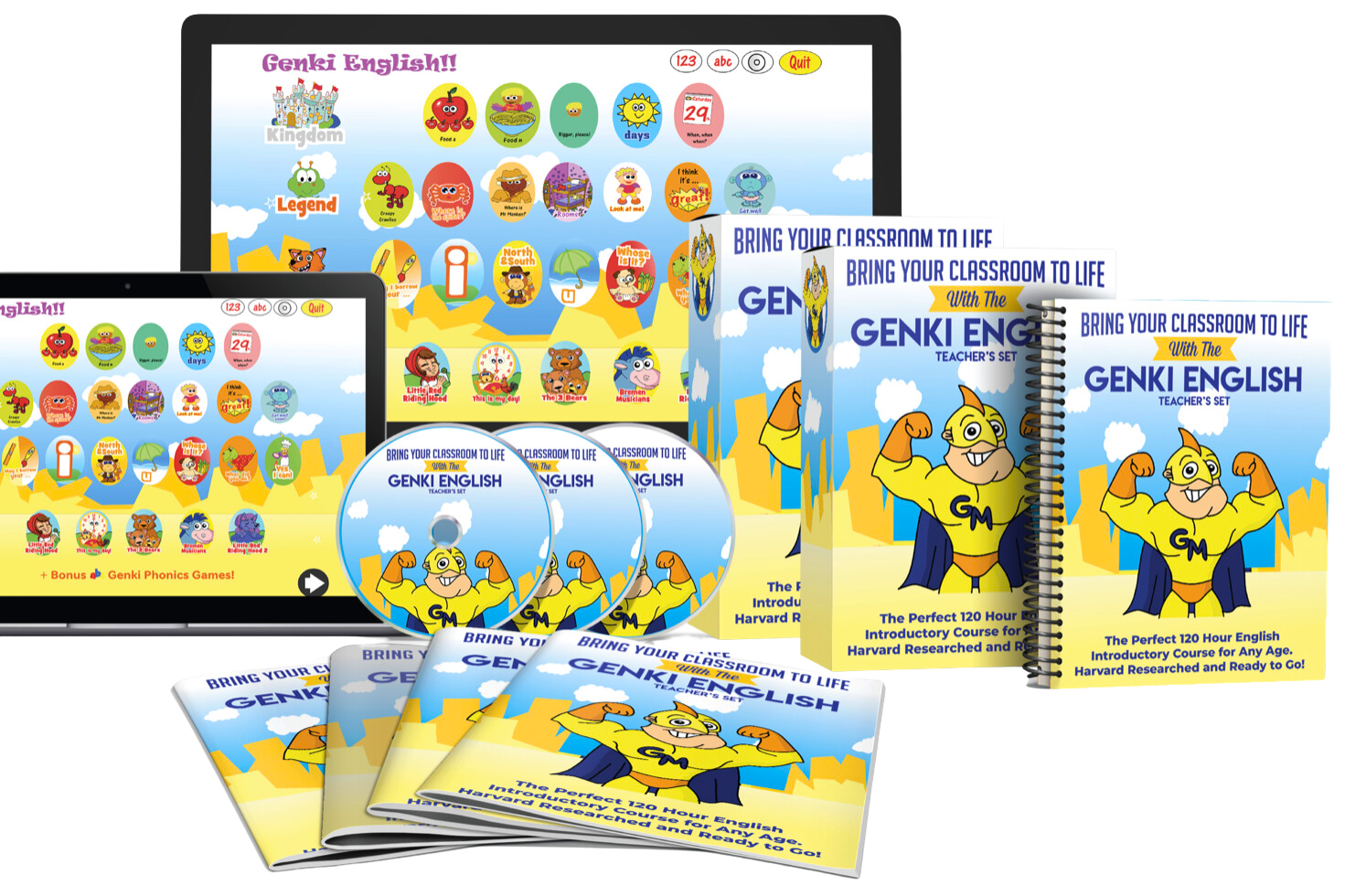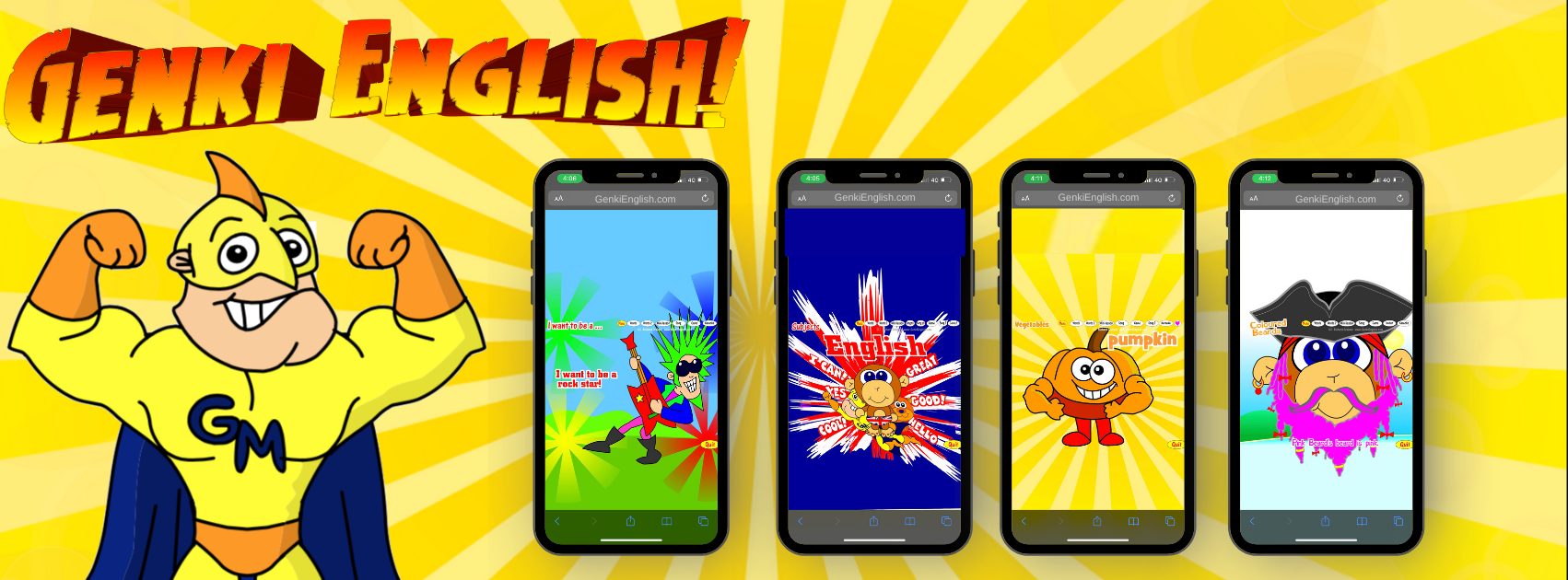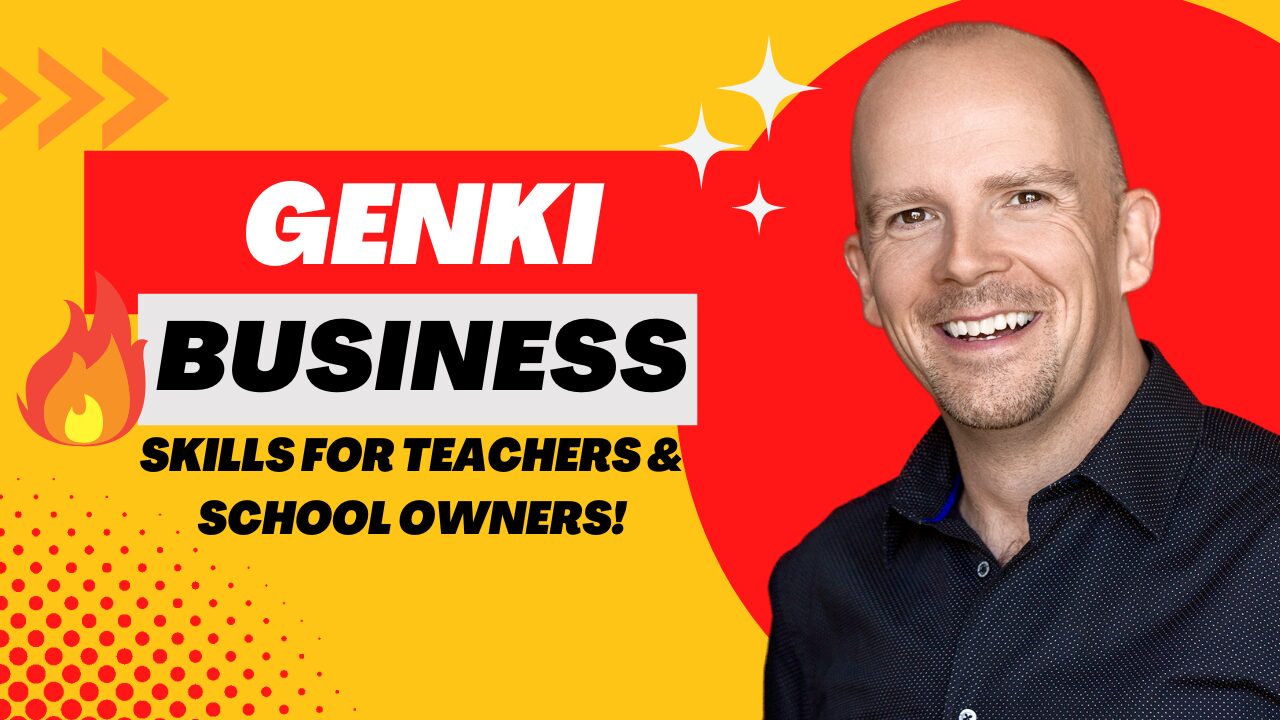UPDATE: Since I wrote this post (and partly because of it) Genki Phonics has now become a full, complete Phonics Course to fulfill all the needs I talk about here!
—————————————————————————————————-
Today I had an intro workshop for a chain with 600 branches and now quite a few genkified teachers.
Afterwards we were chatting and one of the teachers asked “Why doesn’t Genki English have any reading or writing?” My simple answer to that is “Because there are already lots of really good reading and writing courses out there.” Most students in most countries can read and write quite well so there’s no point re-inventing the wheel.*
*after saying this we looked, and there weren’t any good reading courses, so we made one!
I want to speak English!
But it’s the speaking ability that is lacking in just about every country. It’s what employers want, and it’s what most learners want, after all you don’t say “I want to learn to write English” what you say is “I want to learn to speak English.” So that’s what I focus on and why Genki English is so popular.
Our phonics doesn’t work!
But of course traditional reading courses aren’t perfect. So this then led on to talking about phonics. The teacher was saying that although they do teach “phonics” it doesn’t seem to be working. I asked how they were doing it. They said, “well we show the kids a word like “cat” and have them sound it out “See, c, c, Ay, a, a, Tee, t, t” but the kids don’t get it.”
That must confuse the kids like crazy! I see this misunderstanding of what “phonics” actually is quite a lot and if you do it wrong then yes, it doesn’t work. Starting with the letter names is one mistake, and I guess I also confuse people in my courses when I tell them not to do “phonics” at all at the beginning. So let’s try a quick crash course!
Don’t start with phonics, start with “Phonemic Awareness”
“Phonemic awareness” is one of those terms that academics invented to try and make everyone feel inferior, but it’s really quite simple, it just means “hear the sounds.” When you see good teachers introducing new words, along with gestures and visuals, they also vary how they say the word. Sometimes it might be a straight “jump”, the next time it may be “jjjjjump” or “jummmmmmmp” This is not only fun for the kids (all kids love silly voices!) but it helps them listen to not only the word but the component sounds of the word.
Depending on the country you’re in you’ll need more time on some sounds than others. This is also one important reason to study the local language, so that you know which sounds or “phonemes” to concentrate on. For example last year we were letting the teachers in China get away with a “jjj” sound for “r” thinking it was just a one off, until we realised it is a recurring error!
It’s also important to remember that unlike say Chinese or Japanese, there are no set vowel sounds in English. Almost every city in the English speaking world uses different vowel sounds. Even if you say “I want to teach US or UK sounds” then there still isn’t a set standard, a word like “octopus” is pronounced very differently in Georgia compared with upstate New York, LA or Utah. So don’t overly worry about vowels. Obviously you will have a bias for your own sounds, but make sure the kids also experience the vowel sounds of other native speakers (e.g. guest teachers, GE software etc.) so then don’t suddenly become lost when talking to different people. The good news is that for quite a few non native speakers it’s the consonant sounds that are the main barrier to communication so you can concentrate on those.
When to start this?
If you’re doing a serious English course (i.e. actually gaining the ability to communicate in English, not just to pass exams) then you can of course start this right from the beginning. Keep it fun, and keep the conversation as the main aim of the lesson, but stress the sounds in the words where you can.
Some teachers take this one step further by then linking this with letter symbols or “graphemes.” For example stressing one sound in a word and getting kids to point to the letter on the wall or run and grab a foam letter.
I personally don’t introduce graphemes at this stage, but if you want to you can, again just keep it light and fun. The important point is that the sound comes first, then the letter symbol.
Unmissable
Obviously with native speakers this stage isn’t necessary because they’ve had several hundred hours of listening practice already. But in non-native speaking situations this isn’t a stage you can miss. And if you want to move on to reading, then we also have to remember that this stage isn’t actually “phonics” yet.
What age to start phonics?
Before starting real “phonics” we assume the children have already had considerable phonemic awareness, either in class, from a speaking course such as Genki English, or from “extended listening” (not extended reading, extended listening where they listen to dozens of hours of English material) and they can speak the language to some level already. This last bit is important. This can take anything from 20 to 200 hours of class time before you even start real “phonics”.
So what is “phonics” then?
“Phonics” is a pretty broad term, but the generally accepted meaning is the next stage of teaching reading. You can think of it in two parts and I’d run it in parallel to the continuing speaking course.
First, in a very structured manner, you re-introduce the sounds of English and the most common letter that represents this sound e.g. for the “j” sound introduce “j” before the soft “g”. It’s usual to only do one (or maybe two) graphemes per lesson. There are many activities to do this and I’ll try and share some soon. Again this on its own isn’t phonics, you need the next step…
Blending
The second key component is “blending”. As soon as you have taught a handful of graphemes the kids should start learning how to go from seeing “c” and hearing the c sound, seeing the “a” and hearing the a sound, seeing the “t” and hearing the t sound, to gradually move them closer and closer together to eventually come up with c – a – t = cat. Although simple to those of us who learnt it in school, this is a difficult skill and takes time, even with kids in the UK or US.
Being able to blend lots of examples is why many phonics courses don’t use the normal alphabetic order.
This is where it’s very important that the kids can already speak some English. The whole motivation for phonics is that children can the read words they already know. If they have never heard the word “superhero” before, then even if they can say it out it has no meaning for them. Whilst some nonsense words can be good for building the blending skill, the motivation of phonics comes from seeing a word you don’t know how to read, sounding it out, blending it and eventually getting the eureka moment of “Wow, that says my hobby!!!!!!” Of course if they haven’t learnt the word in a song or by listening before hand then all they read is the equivalent of “hjdshfjkdshfdlhs” which has zero motivation for them.
The trap!
The trap here is that if the kids only know a few words e.g. a few animals or colours, then they may just be remembering the shape of the words from flashcards. This again isn’t blending and isn’t reading. Here you could use more nonsense words, but that is really just a sign that you have started phonics too soon. It’s another reason why they have to have a lot of listening and speaking beforehand, so that you can introduce longer words that they couldn’t have remembered.
( Side note: This is one problem with using Genki English only. As the GE language is taken from the language kids use most often it is the most phonetically irregular and whilst being great for communication it doesn’t give the best examples to use in a phonics course. Hence we’ve added a few phonics specific lessons to the main curriculum to fill all the gaps e.g. ure, i, o, u )
How long to spend on phonics?
Real phonics does take time to teach, I think we’re looking at around 30 classroom hours at the moment for the basic set or 70 x 5 minutes for the “5 minute Genki Phonics”. There are many other good courses out there such as the UK’s Letters & Sounds or Jolly Phonics programmes.
Once you’ve done this stage and have added in some of the non-phonetic high use words such as “the” or “I”, kids can read about 80% of English.
Which is pretty cool.
Then you can, if you wish, introduce the names of the letters e.g. ay, bee, see etc.
From then on it’s a case of teaching the other ways of writing the English sounds, such as “igh” or “dge” to slowly crawl up to nearer 100%.
So to sum it up:
1. Learn to listen & speak + phonemic awareness
2. Keep learning to listen & speak, plus learn to read with phonics
3. Keep learning to listen & speak, keep practising reading, plus a traditional writing course. (I currently recommend OUP’s Read, Write, Inc. for this stage)
Or if you have limited classroom time my recommendation is to just do stage one in primary school and leave the others as a new challenge for (junior) high school!




A really usefull blog post this one. Thanks!
Yup, I agree Julian-k.
Same here , so meaningful and important. Thanks for the tips.
Yes – good stuff. Plenty of food for thought. Thanks.
This is so smart! Thanks for mentioning it in your recent post. I intuitively felt students should have 36 to 72 hours of English speaking and listening before they tackle reading, but this sets out the “why” so clearly. Bookmarked for future reference! (Is this available in Japanese anywhere on the site? If not, I still really appreciate having it in clear, clean English! Thank you again!)
Glad you like it Micki, I haven’t written the exact same in Japanese, but this is what I wrote for the Japanese newsletters:
今日はABCの教え方です!
まだ、このメールで、アルファベットやABCについてやっていない事に気付いたかもしれません
確かに、それが最初に教える事ですね。
えーっと、そうなんですが、そうでもないんです。
僕が意味していることをお見せする為に、「5分間でABC」という短いビデオを用意しました。
http://genkienglish.net/eigo/5minphonics
ここでもう少しヒントがあります。
1. 「名称」の文字よりも「音」を試してみて
Sounds not names
==================================
たいていは名称よりも前に文字の「音」からスタートするのがいいアイディアです。
例えば、”ay bee see.”よりも音のa,b,c で “hat”, “bug” “cat” というように。
これが「フォニックス」と呼ばれるものです。
なぜ?
なぜなら、これによって、子供たちが読む事ができるのです。とっても、とっても早く。
これってかなり凄いでしょ。
2. 文字よりも前に単語を習うように心がけて
Before the letters, do the words.
==================================
赤ちゃんは新しい音をとっても、とってもよく覚える。
実際、言語を早くから習うという大きな理由の一つです
しかし、子供たち(大人も)しばしば、個々の音を単語や文と比較して覚えるのは難しい
それゆえ、大抵は、日本語の発音にそっと戻ってしまいます。
And … 簡単にこれが治せます
単に、沢山の単語や文を先にに習い、その後で、個々の音に切っていきます。
3. 大文字のまえに小文字
Small is first!
=======================
単語や文を先に習ってくれてうれしく思います。では、文字の「音」と文字をご紹介する時がきました。
しかし、どっちが先? 小文字(abc)それとも大文字(ABC)文字?
えーっと、どれだけの小文字がこのメッセージの英語版にあるか数えてみて。
http://genkienglish.net/teaching/how-to-teach-abcs/
そして、どれだけの大文字があるか数えてみて。
どっちが人気があるか結構簡単にわかりますよね!
これらは、ちょっとした考え方のアイディアです
遠慮しないで僕に質問してきて下さい(でも簡単なのがいいね)そして、あなたの為に作った「5分間でABC」ビデオもチェックしてください。スタートするのに必要ものが全て揃っているよ。
http://genkienglish.net/eigo/5minphonics
Be genki,
Richard
P.S.:もし、 “b” と “d” が混乱している子供たちがいたら、しばしば教える順番を変え、文字を教えるのもいいアイディアです。ビデオを見て!それは、英国政府が子供たちの為に最小の混乱にするよう推奨していることを示しています。
P.P.S. 学校によっては、違った教え方をさせようとしたり、させる場合もあります。しかし、とっても良い事に、元気フォニックスは簡単に結果が計ります。だから1クラスは普通の方法で、もう1クラスは元気フォニックスの方法でやってみて、それは両親や校長先生ですら、どっちが効果的かとても明白です。真剣に魔法のようなものなのです!
Thank you so much! I’ll take a look at it this week.
Thank you so much for the tips and advice!
I have only one question: After completing all the lessons of the Genki Engish course (including the Genki phonics) which of the OUP’s Read, Write, Inc. series do you recommend? Read, Write Inc. Phonics or Read, Write Inc. Literacy and Language (Year 2)? Thank you!
Hi Lina,
I can’t remember exactly which books it was but we just skipped all the RWI phonics and moved straight into the creative reading!
(Which is very similar to what we’re doing now with the Genki English Writing programme, so you might even be able to get away with not needing RWI!)
http://genkienglish.net/teaching/how-to-teach-writing/
Thank you very much for your reply!I had a look at the link you gave me and I think that imagination worksheets is the best step for my students to take at this point. Nevertheless, being a non-native speaker of English and a great fan of your work, I’d love to see a more structured GE writing programme (something like the GE curriculum with the lesson plans). I wouldn’t miss it for the world!